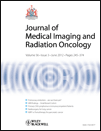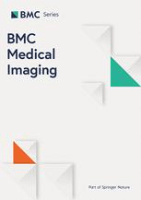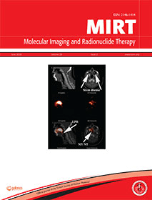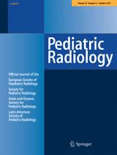
Radiology-Imaging Cancer
Scope & Guideline
Illuminate the Future of Oncology with Cutting-Edge Radiology.
Introduction
Aims and Scopes
- Oncologic Imaging Techniques:
The journal covers a wide range of imaging modalities, including MRI, CT, PET, and ultrasound, focusing on their applications in cancer diagnosis and treatment. - Artificial Intelligence in Radiology:
There is a significant emphasis on the integration of AI and machine learning technologies in imaging, particularly for improving diagnostic accuracy and workflow efficiency. - Multimodality Imaging Approaches:
Research on combining different imaging techniques to enhance diagnostic capabilities and therapeutic monitoring is prevalent, showcasing the importance of a multimodal perspective. - Theranostics and Personalized Medicine:
The journal explores theranostic approaches that combine diagnostic imaging with targeted therapy, emphasizing personalized treatment strategies for cancer patients. - Patient-Centered Care and Health Disparities:
There is a focus on the impact of demographic factors on cancer imaging practices and patient outcomes, highlighting the importance of equitable access to imaging services.
Trending and Emerging
- AI and Machine Learning Applications:
The integration of AI in imaging diagnostics is trending, with numerous studies exploring its potential to enhance accuracy and efficiency in cancer detection. - Molecular Imaging and Biomarkers:
Research focusing on molecular imaging techniques and their role in identifying biomarkers for cancer prognosis and treatment response is gaining traction. - Digital Health and Telemedicine:
The impact of digital health technologies, including telemedicine, on cancer imaging and patient management is an emerging theme, especially highlighted by the pandemic. - Radiomics and Quantitative Imaging:
The use of radiomics to extract quantitative features from imaging data for predictive modeling and personalized treatment is increasingly prominent. - Health Equity in Cancer Imaging:
There is a growing emphasis on addressing health disparities in cancer imaging practices, focusing on equitable access and outcomes for diverse populations.
Declining or Waning
- Traditional Imaging Techniques:
There appears to be a decline in studies focused solely on traditional imaging methods without the integration of advanced technologies or multimodal approaches. - Generalized Screening Protocols:
Research aimed at broad, generalized screening guidelines is decreasing, likely as more personalized and risk-based screening strategies emerge. - Invasive Procedures without Imaging Guidance:
As imaging technology advances, there is less emphasis on invasive diagnostic procedures that do not utilize imaging guidance, reflecting a trend towards more minimally invasive techniques. - Basic Radiological Education:
The focus on foundational radiology education has waned in favor of more specialized and advanced topics relevant to oncologic imaging. - Single-institution Studies:
There is a noticeable reduction in the publication of single-institution studies, with a shift towards larger, multi-institutional collaborations that enhance the generalizability of findings.
Similar Journals

Journal of Medical Imaging and Radiation Oncology
Fostering Innovation in Imaging for Enhanced Cancer CareJournal of Medical Imaging and Radiation Oncology, published by WILEY, is a pivotal resource in the fields of oncology and medical imaging. With an impact factor reflective of its commitment to advancing research, the journal has maintained a robust reputation since its inception in 2008 and continues to thrive through 2024. It is indexed with an insightful ranking, with a Q2 classification in Radiology, Nuclear Medicine and Imaging, affirming its importance in these disciplines. This journal not only serves as an open access platform, allowing extensive reach and accessibility, but also fosters a scholarly community dedicated to the innovation of imaging techniques and radiation oncology practices. As a key player in disseminating crucial findings and advancements, it appeals to researchers, clinicians, and students who aim to contribute to the evolving landscape of medical imaging and cancer treatment methodologies. The journal is based in Australia, at 111 River St, Hoboken, NJ, and invites submissions that push the boundaries of current knowledge in this critical area of healthcare.

European Journal of Hybrid Imaging
Integrating Science and Technology for Better Imaging SolutionsEuropean Journal of Hybrid Imaging, published by SpringerNature, stands as a pivotal platform for scholarly discourse in the rapidly evolving fields of hybrid imaging technologies and methodologies. Since its inception in 2017, this open access journal has significantly contributed to the interdisciplinary interface of biophysics, computer science, molecular medicine, and radiology. With its current standing in the Q2 and Q3 quartiles across various categories, it provides valuable insights and research outputs pertinent to both academic and clinical practitioners. The journal's rigorous peer-review process ensures the highest standards of scholarly integrity, while its open access format promotes global accessibility and encourages collaborative research efforts. Covering a diverse range of topics pertinent to hybrid imaging, the journal serves as an essential resource for researchers, professionals, and students alike, fostering innovation and knowledge exchange within the scientific community.

BMC MEDICAL IMAGING
Advancing the Future of Radiology and Imaging Technologies.BMC Medical Imaging is a premier open-access journal dedicated to advancing the field of radiology, nuclear medicine, and imaging technologies. Published by BMC in the United Kingdom, this journal serves as a vital resource for researchers, clinicians, and students, fostering a collaborative environment for sharing innovative findings and methodologies in medical imaging. With a commendable impact factor and an impressive Scopus ranking within the top 35% of its category, BMC Medical Imaging provides a platform for high-quality research to be disseminated widely and freely since its inception in 2001. The journal aims to cover a diverse array of topics, from advanced imaging techniques to their clinical applications, enhancing the understanding and effectiveness of diagnostic practices. By contributing to the body of knowledge and facilitating open access to research, BMC Medical Imaging plays a pivotal role in shaping the future of medical imaging and improving patient care.

Indian Journal of Radiology and Imaging
Connecting Global Minds in Radiology and ImagingThe Indian Journal of Radiology and Imaging, published by THIEME MEDICAL PUBL INC, is a prominent open-access journal in the field of radiology, nuclear medicine, and imaging. Since its inception in 1984, the journal has provided a platform for researchers, professionals, and students to disseminate innovative research and findings in diagnostic imaging. With a growing impact factor and categorized in the Q3 quartile according to the 2023 rankings, it ranks among the notable journals in its field, although it currently stands at Rank #244 out of 333 within Scopus, reflecting its competitive position in radiology research. The journal, accessible to a global audience since 1999, aims to advance the knowledge and practice in imaging by inviting diverse contributions, including original research articles, reviews, and case reports. Its commitment to open-access publication fosters wider dissemination and collaborative discourse, crucial for the dynamic landscape of medical imaging.

PET Clinics
Innovating Patient Care through PET Insights.PET Clinics, published by Elsevier Inc, is a premier academic journal focusing on the advancements and applications of Positron Emission Tomography (PET) in various medical fields. With its ISSN 1556-8598 and E-ISSN 1559-7814, the journal has established a strong reputation in the scientific community, reflected in its impressive Q1 quartile rankings in Medicine (miscellaneous), Radiation, and Radiology, Nuclear Medicine, and Imaging for 2023. The journal operates within a well-defined scope that bridges innovative research and practical clinical applications, targeting professionals, researchers, and students keen on the intersection of nuclear medicine and imaging technologies. Although not an open-access journal, PET Clinics ensures accessibility through institutional subscriptions, making valuable insights available to the academic community. With an emphasis on enhancing patient care and treatment outcomes through cutting-edge imaging techniques, this journal serves as an essential resource for those seeking to expand their knowledge and expertise in the rapidly evolving field of PET.

Molecular Imaging and Radionuclide Therapy
Elevating the standards of molecular imaging research.Molecular Imaging and Radionuclide Therapy is an esteemed academic journal published by GALENOS PUBL HOUSE, dedicated to advancing the fields of radiology, nuclear medicine, and imaging. Since its inception, this Open Access journal has facilitated the dissemination of high-quality research and innovative practices in molecular imaging and radionuclide therapy, making it a vital resource for researchers, professionals, and students alike. With an ISSN of 2146-1414 and an E-ISSN of 2147-1959, the journal has established its presence globally while specifically catering to the Turkish academic and medical community. As of 2023, it is ranked #241/333 in the Radiology, Nuclear Medicine and Imaging category on Scopus, holding a respectable Q3 quartile ranking. The journal serves as a platform for sharing impactful findings from 2017 to 2024, reinforcing its commitment to open access since 2011. With a dedication to enhancing the knowledge base in molecular imaging and therapy, it remains an important conduit for scholarly communication and collaborative research developments in this dynamic field.

Japanese Journal of Radiology
Elevating Radiology Research to New HeightsThe Japanese Journal of Radiology, published by SPRINGER, serves as a premier platform for disseminating cutting-edge research and clinical advancements in the fields of radiology, nuclear medicine, and imaging. With an ISSN of 1867-1071 and E-ISSN 1867-108X, this journal has established itself as a vital resource for practitioners, researchers, and students alike. Renowned for its high-quality peer-reviewed articles, it currently enjoys a respectable impact factor within the Q2 category of Scopus rankings, placing it in the 69th percentile among 333 journals in its field. The journal has seen consistent convergence of research from 2009 to 2024, further underscoring its commitment to advancing the understanding of radiological practices. Importantly, the journal offers Open Access options to facilitate widespread dissemination of knowledge, ensuring that vital research reaches its audience without barriers. Addressed in Japan, the Japanese Journal of Radiology plays a critical role in enhancing the global discourse on medical imaging, making it an essential resource for anyone engaged in this dynamic field.

EUROPEAN JOURNAL OF RADIOLOGY
Transforming Patient Care Through Radiological ResearchThe European Journal of Radiology, published by Elsevier Ireland Ltd, is a premier peer-reviewed journal in the fields of radiology, nuclear medicine, and imaging. Established in 1981, it has carved a significant niche within the academic community, showcasing innovative research that enhances medical imaging practices and improves patient care. With an impressive ranking in the Q1 category for both Medicine (miscellaneous) and Radiology, Nuclear Medicine, and Imaging in 2023, the journal is recognized globally for its commitment to advancing scientific knowledge and improving imaging methodologies. The journal's Scopus ranking of #60/333, placing it in the 82nd percentile, underlines its reputation for high-quality research and scholarly contributions. While traditionally a subscription-based journal, it continually evolves to meet the demands of the academic landscape, aiming to bridge the gap between research and clinical practice. Researchers, healthcare professionals, and students alike can benefit from exploring its extensive archives and current publications, which are curated to foster education and innovation in the medical imaging domain.

EUROPEAN RADIOLOGY
Advancing the Frontiers of Medical ImagingEUROPEAN RADIOLOGY, published by SPRINGER, stands as a prestigious international journal in the field of radiology, nuclear medicine, and imaging, with an impressive impact factor that underscores its significance among peers. With an ISSN of 0938-7994 and an E-ISSN of 1432-1084, this journal provides a platform for cutting-edge research and advancements in medical imaging from 1991 to 2024. Recognized as a Q1 journal in both general Medicine and the specialized Radiology category by 2023, EUROPEAN RADIOLOGY ranks an impressive #17 out of 333 in its field according to Scopus, placing it in the 95th percentile. While it does not currently offer Open Access options, the journal remains essential reading for researchers, professionals, and students striving to stay at the forefront of developments in diagnostic imaging and related technologies. By contributing to a comprehensive understanding of radiological practices, EUROPEAN RADIOLOGY plays a crucial role in shaping the future of medical diagnosis and patient care.

PEDIATRIC RADIOLOGY
Empowering clinicians through cutting-edge research.Pediatric Radiology is a leading journal published by Springer that provides a crucial platform for the dissemination of research in the fields of pediatrics, perinatology, and radiology. Since its inception in 1973, the journal has continually contributed to the advancement of medical imaging techniques and their application in diagnosing and treating pediatric conditions. With its impact factor reflecting a Q2 ranking in both Pediatrics and Radiology categories as of 2023, Pediatric Radiology is highly regarded in scholarly circles, aiding researchers, clinicians, and students to stay at the forefront of innovations and findings in the field. Although the journal does not offer open access, it continues to be an essential resource for evidence-based information that enhances clinical practice and improves health outcomes for children globally. The journal's reach is further established through its solid Scopus rankings, indicating its relevance and influence in the global medical community.